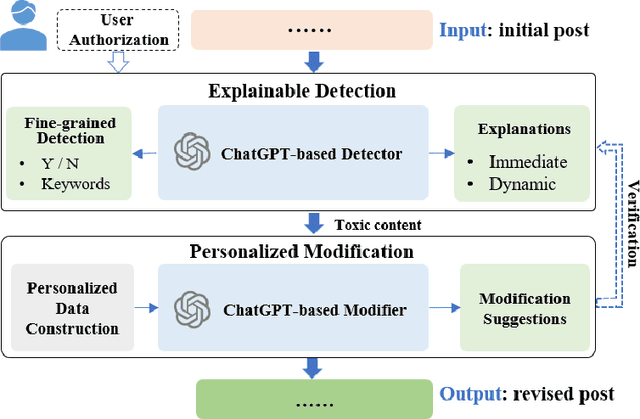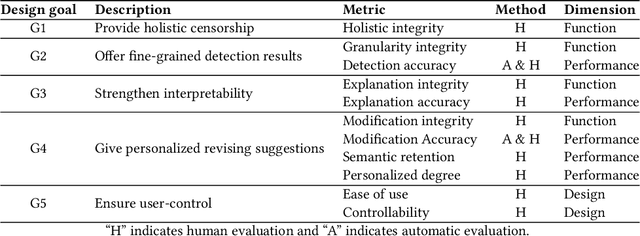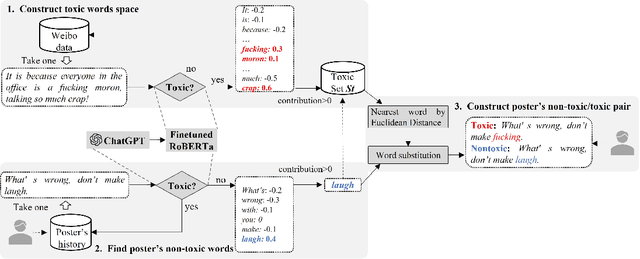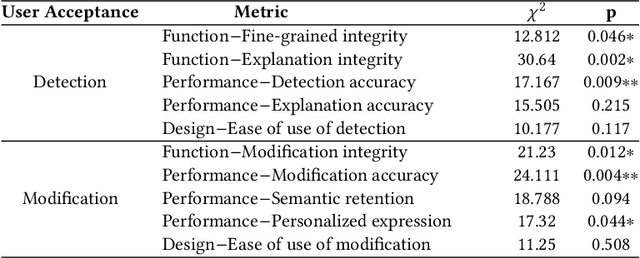Tun Lu
IROTE: Human-like Traits Elicitation of Large Language Model via In-Context Self-Reflective Optimization
Aug 12, 2025



Abstract:Trained on various human-authored corpora, Large Language Models (LLMs) have demonstrated a certain capability of reflecting specific human-like traits (e.g., personality or values) by prompting, benefiting applications like personalized LLMs and social simulations. However, existing methods suffer from the superficial elicitation problem: LLMs can only be steered to mimic shallow and unstable stylistic patterns, failing to embody the desired traits precisely and consistently across diverse tasks like humans. To address this challenge, we propose IROTE, a novel in-context method for stable and transferable trait elicitation. Drawing on psychological theories suggesting that traits are formed through identity-related reflection, our method automatically generates and optimizes a textual self-reflection within prompts, which comprises self-perceived experience, to stimulate LLMs' trait-driven behavior. The optimization is performed by iteratively maximizing an information-theoretic objective that enhances the connections between LLMs' behavior and the target trait, while reducing noisy redundancy in reflection without any fine-tuning, leading to evocative and compact trait reflection. Extensive experiments across three human trait systems manifest that one single IROTE-generated self-reflection can induce LLMs' stable impersonation of the target trait across diverse downstream tasks beyond simple questionnaire answering, consistently outperforming existing strong baselines.
Bidirectional Knowledge Distillation for Enhancing Sequential Recommendation with Large Language Models
May 23, 2025Abstract:Large language models (LLMs) have demonstrated exceptional performance in understanding and generating semantic patterns, making them promising candidates for sequential recommendation tasks. However, when combined with conventional recommendation models (CRMs), LLMs often face challenges related to high inference costs and static knowledge transfer methods. In this paper, we propose a novel mutual distillation framework, LLMD4Rec, that fosters dynamic and bidirectional knowledge exchange between LLM-centric and CRM-based recommendation systems. Unlike traditional unidirectional distillation methods, LLMD4Rec enables iterative optimization by alternately refining both models, enhancing the semantic understanding of CRMs and enriching LLMs with collaborative signals from user-item interactions. By leveraging sample-wise adaptive weighting and aligning output distributions, our approach eliminates the need for additional parameters while ensuring effective knowledge transfer. Extensive experiments on real-world datasets demonstrate that LLMD4Rec significantly improves recommendation accuracy across multiple benchmarks without increasing inference costs. This method provides a scalable and efficient solution for combining the strengths of both LLMs and CRMs in sequential recommendation systems.
FedCIA: Federated Collaborative Information Aggregation for Privacy-Preserving Recommendation
Apr 19, 2025Abstract:Recommendation algorithms rely on user historical interactions to deliver personalized suggestions, which raises significant privacy concerns. Federated recommendation algorithms tackle this issue by combining local model training with server-side model aggregation, where most existing algorithms use a uniform weighted summation to aggregate item embeddings from different client models. This approach has three major limitations: 1) information loss during aggregation, 2) failure to retain personalized local features, and 3) incompatibility with parameter-free recommendation algorithms. To address these limitations, we first review the development of recommendation algorithms and recognize that their core function is to share collaborative information, specifically the global relationship between users and items. With this understanding, we propose a novel aggregation paradigm named collaborative information aggregation, which focuses on sharing collaborative information rather than item parameters. Based on this new paradigm, we introduce the federated collaborative information aggregation (FedCIA) method for privacy-preserving recommendation. This method requires each client to upload item similarity matrices for aggregation, which allows clients to align their local models without constraining embeddings to a unified vector space. As a result, it mitigates information loss caused by direct summation, preserves the personalized embedding distributions of individual clients, and supports the aggregation of parameter-free models. Theoretical analysis and experimental results on real-world datasets demonstrate the superior performance of FedCIA compared with the state-of-the-art federated recommendation algorithms. Code is available at https://github.com/Mingzhe-Han/FedCIA.
Enhancing Cross-Domain Recommendations with Memory-Optimized LLM-Based User Agents
Feb 19, 2025Abstract:Large Language Model (LLM)-based user agents have emerged as a powerful tool for improving recommender systems by simulating user interactions. However, existing methods struggle with cross-domain scenarios due to inefficient memory structures, leading to irrelevant information retention and failure to account for social influence factors such as popularity. To address these limitations, we introduce AgentCF++, a novel framework featuring a dual-layer memory architecture and a two-step fusion mechanism to filter domain-specific preferences effectively. Additionally, we propose interest groups with shared memory, allowing the model to capture the impact of popularity trends on users with similar interests. Through extensive experiments on multiple cross-domain datasets, AgentCF++ demonstrates superior performance over baseline models, highlighting its effectiveness in refining user behavior simulation for recommender systems. Our code is available at https://anonymous.4open.science/r/AgentCF-plus.
Mitigating Popularity Bias in Collaborative Filtering through Fair Sampling
Feb 19, 2025Abstract:Recommender systems often suffer from popularity bias, where frequently interacted items are overrepresented in recommendations. This bias stems from propensity factors influencing training data, leading to imbalanced exposure. In this paper, we introduce a Fair Sampling (FS) approach to address this issue by ensuring that both users and items are selected with equal probability as positive and negative instances. Unlike traditional inverse propensity score (IPS) methods, FS does not require propensity estimation, eliminating errors associated with inaccurate calculations. Our theoretical analysis demonstrates that FS effectively neutralizes the influence of propensity factors, achieving unbiased learning. Experimental results validate that FS outperforms state-of-the-art methods in both point-wise and pair-wise recommendation tasks, enhancing recommendation fairness without sacrificing accuracy. The implementation is available at https://anonymous.4open.science/r/Fair-Sampling.
Enhancing LLM-Based Recommendations Through Personalized Reasoning
Feb 19, 2025Abstract:Current recommendation systems powered by large language models (LLMs) often underutilize their reasoning capabilities due to a lack of explicit logical structuring. To address this limitation, we introduce CoT-Rec, a framework that integrates Chain-of-Thought (CoT) reasoning into LLM-driven recommendations by incorporating two crucial processes: user preference analysis and item perception evaluation. CoT-Rec operates in two key phases: (1) personalized data extraction, where user preferences and item perceptions are identified, and (2) personalized data application, where this information is leveraged to refine recommendations. Our experimental analysis demonstrates that CoT-Rec improves recommendation accuracy by making better use of LLMs' reasoning potential. The implementation is publicly available at https://anonymous.4open.science/r/CoT-Rec.
Value Compass Leaderboard: A Platform for Fundamental and Validated Evaluation of LLMs Values
Jan 13, 2025Abstract:As Large Language Models (LLMs) achieve remarkable breakthroughs, aligning their values with humans has become imperative for their responsible development and customized applications. However, there still lack evaluations of LLMs values that fulfill three desirable goals. (1) Value Clarification: We expect to clarify the underlying values of LLMs precisely and comprehensively, while current evaluations focus narrowly on safety risks such as bias and toxicity. (2) Evaluation Validity: Existing static, open-source benchmarks are prone to data contamination and quickly become obsolete as LLMs evolve. Additionally, these discriminative evaluations uncover LLMs' knowledge about values, rather than valid assessments of LLMs' behavioral conformity to values. (3) Value Pluralism: The pluralistic nature of human values across individuals and cultures is largely ignored in measuring LLMs value alignment. To address these challenges, we presents the Value Compass Leaderboard, with three correspondingly designed modules. It (i) grounds the evaluation on motivationally distinct \textit{basic values to clarify LLMs' underlying values from a holistic view; (ii) applies a \textit{generative evolving evaluation framework with adaptive test items for evolving LLMs and direct value recognition from behaviors in realistic scenarios; (iii) propose a metric that quantifies LLMs alignment with a specific value as a weighted sum over multiple dimensions, with weights determined by pluralistic values.
Oracle-guided Dynamic User Preference Modeling for Sequential Recommendation
Dec 01, 2024



Abstract:Sequential recommendation methods can capture dynamic user preferences from user historical interactions to achieve better performance. However, most existing methods only use past information extracted from user historical interactions to train the models, leading to the deviations of user preference modeling. Besides past information, future information is also available during training, which contains the ``oracle'' user preferences in the future and will be beneficial to model dynamic user preferences. Therefore, we propose an oracle-guided dynamic user preference modeling method for sequential recommendation (Oracle4Rec), which leverages future information to guide model training on past information, aiming to learn ``forward-looking'' models. Specifically, Oracle4Rec first extracts past and future information through two separate encoders, then learns a forward-looking model through an oracle-guiding module which minimizes the discrepancy between past and future information. We also tailor a two-phase model training strategy to make the guiding more effective. Extensive experiments demonstrate that Oracle4Rec is superior to state-of-the-art sequential methods. Further experiments show that Oracle4Rec can be leveraged as a generic module in other sequential recommendation methods to improve their performance with a considerable margin.
DeMod: A Holistic Tool with Explainable Detection and Personalized Modification for Toxicity Censorship
Nov 04, 2024



Abstract:Although there have been automated approaches and tools supporting toxicity censorship for social posts, most of them focus on detection. Toxicity censorship is a complex process, wherein detection is just an initial task and a user can have further needs such as rationale understanding and content modification. For this problem, we conduct a needfinding study to investigate people's diverse needs in toxicity censorship and then build a ChatGPT-based censorship tool named DeMod accordingly. DeMod is equipped with the features of explainable Detection and personalized Modification, providing fine-grained detection results, detailed explanations, and personalized modification suggestions. We also implemented the tool and recruited 35 Weibo users for evaluation. The results suggest DeMod's multiple strengths like the richness of functionality, the accuracy of censorship, and ease of use. Based on the findings, we further propose several insights into the design of content censorship systems.
Constructing and Masking Preference Profile with LLMs for Filtering Discomforting Recommendation
Oct 07, 2024



Abstract:Personalized algorithms can inadvertently expose users to discomforting recommendations, potentially triggering negative consequences. The subjectivity of discomfort and the black-box nature of these algorithms make it challenging to effectively identify and filter such content. To address this, we first conducted a formative study to understand users' practices and expectations regarding discomforting recommendation filtering. Then, we designed a Large Language Model (LLM)-based tool named DiscomfortFilter, which constructs an editable preference profile for a user and helps the user express filtering needs through conversation to mask discomforting preferences within the profile. Based on the edited profile, DiscomfortFilter facilitates the discomforting recommendations filtering in a plug-and-play manner, maintaining flexibility and transparency. The constructed preference profile improves LLM reasoning and simplifies user alignment, enabling a 3.8B open-source LLM to rival top commercial models in an offline proxy task. A one-week user study with 24 participants demonstrated the effectiveness of DiscomfortFilter, while also highlighting its potential impact on platform recommendation outcomes. We conclude by discussing the ongoing challenges, highlighting its relevance to broader research, assessing stakeholder impact, and outlining future research directions.
 Add to Chrome
Add to Chrome Add to Firefox
Add to Firefox Add to Edge
Add to Edge